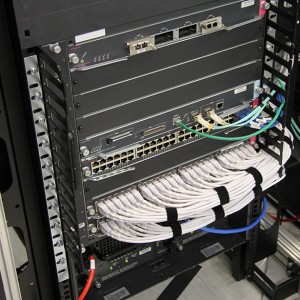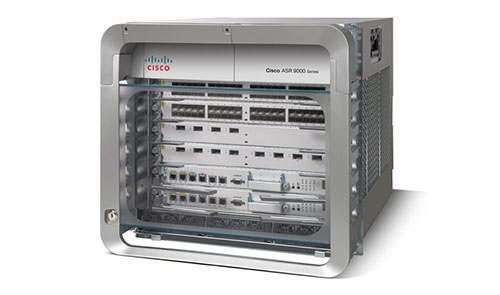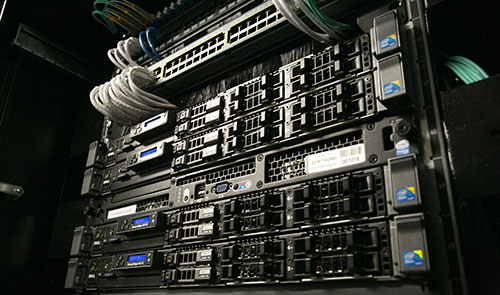Data Centre Cable Management – Not As Hard As You Think

Imagine replacing a line card here if all 96 cables weren’t routed properly.
Tidy racks – it’s a small thing, but something we’re immensely proud of. One of the things that sets us apart is well designed cabs with great cable management, not only for our managed customer racks but our internal network and systems racks too. In fact, these are arguably more important to keep immaculate due to the huge number of cables being patched there on a weekly basis – if you’ve never seen your transit provider’s network rack, you’ll probably want to remain in blissful ignorance – it’s usually not pretty.
I’m sure everyone has seen those legacy racks, where the patch leads remind you of spaghetti junction and you wonder when the engineers just stopped caring about using the correct length, route, or anything other than getting the circuit up.
I liken it to the ‘broken windows‘ theory, famously implemented in New York City under Mayor Rudy Giuliani as part of his ‘zero tolerance’ program. The name comes from the following example:
Consider a building with a few broken windows. If the windows are not repaired, the tendency is for vandals to break a few more windows. Eventually, they may even break into the building, and if it’s unoccupied, perhaps become squatters or light fires inside.
Or consider a pavement. Some litter accumulates. Soon, more litter accumulates. Eventually, people even start leaving bags of refuse from take-out restaurants there or even break into cars.
'Broken Windows' - James Q. Wilson and George L. Kelling
Imagine a new rack with freshly installed equipment, the few cables there are routed neatly and labelled – maybe even some cable management bars and patch panels are being used. Now picture arriving at that same rack a few months later. A few new circuits have been patched. The first couple were done very neatly but then one or two weren’t – the engineer didn’t have the correct colour cable to fit in with the scheme, and he used a 3m length when a 0.5m would have been perfect. He said to himself he’d come back and replace it, but then forgot.
How important are you now likely to deem the colour scheme? It’s already been broken. Why should you bother to crimp that overlong cable to length? No one else does. And so begins the gradual decline in standards that can lead to cabinets like these (warning – not suitable for those with weak dispositions). Now all isn’t yet lost – we’ve repeatedly performed ‘remedial’ work for customers who’s cabling has gotten away from them – but wouldn’t it be nice if you didn’t have these problems in the first place?
There are ways you can influence how the rack will be maintained, even starting as early as the initial design stage. There are many elements to consider when initially designing the layout of your new rack – airflow, weight distribution, the addition of future devices. One that’s often overlooked or not taken as seriously as it should is cable management. When the initial diagrams are drawn up, the following things should have been considered:
- If this is a network/patching rack, is it worth ordering an 800mm wide cab to allow room for cabling?
- What route will new cables take?
- Are new DC cable runs brought in from under the floor or overhead?
- Will we be implementing a colour scheme to differentiate between network/management?
- How will engineers (especially remote hands or new starters) know which colour to use and which route to take?
- How will you make sure core fibre is protected from becoming tangled with other cables and damaged?
- If there are DA cables or fibre, will the radius be too constricted following this cable route?
- If you’re running a couple of cables between racks, will you need to run more in the future?
- If so would it make more sense to pre-patch a couple of 12/24/48 port patch panels from day one?
- If the ports on the switch are front facing, would it help to pre-patch the entire switch to a patch panel at the back?
- Is there anything else that can be pre-patched to eliminate issues further down the line?
To avoid that problem of engineers using 3m cables for everything, even if it’s to patch to a device one unit below, consider storing some short length patch leads somewhere within the rack. We’ve made it standard practice to install lockable rack mounted drawers to keep a stash of these and other accessories that might be needed, making sure that these are checked and restocked when required.
Bits you might need:
- A range of copper patch leads in different colours/lengths.
- A range of fibre patch leads in different types/connector combinations/lengths – we have custom fibre made in lengths like 0.2m/0.5m/0.75m which are surprisingly useful.
- Velcro. Lots and lots of velcro. More than you think you need.
- A few different types of spare Dymo tape cassettes – we use wrap labels for power/copper and flag labels for fibre.
- Crimp tool and RJ45 ends – now there’s no excuse for using a cable that’s too long.
- Colour scheme/cable route crib sheet – this could also have info on where new devices are to be patched (ie all new NTEs at the bottom of the rack etc).
Once you’ve prepped the rack with immaculate cable management in mind, apply the ‘zero tolerance’ approach. Make the time to audit your racks regularly and take appropriate action to rectify any issues when they happen. Make neat, correct, labelled cables not just a nice to have, but the norm, and anything else unacceptable. And enjoy your neat and tidy cabs!







